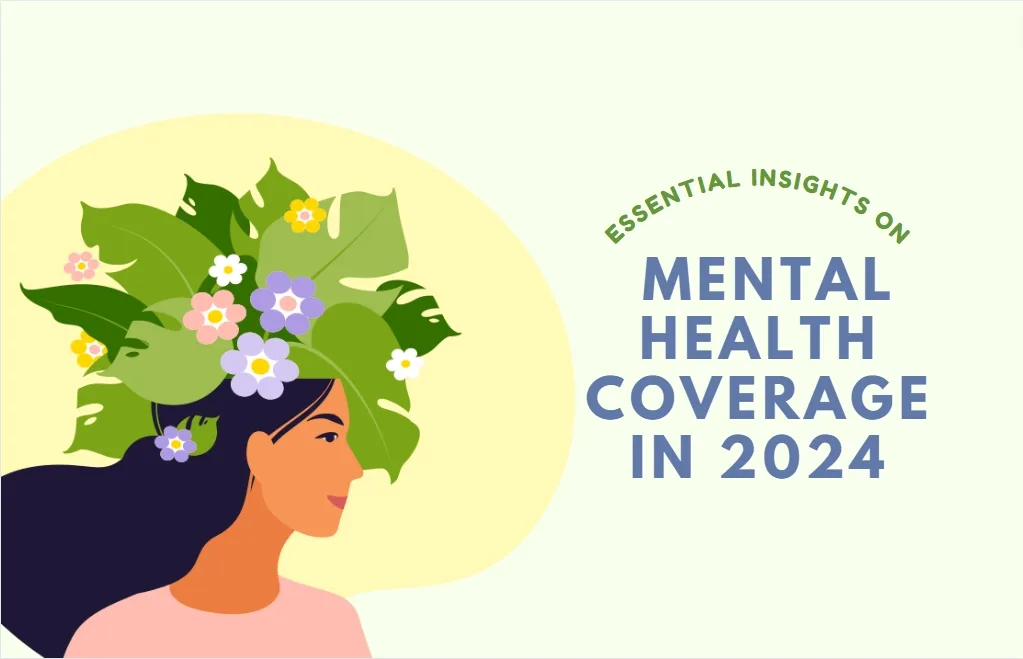In the ever-evolving landscape of healthcare, Mental Health Coverage remains a critical component of personal well-being. As we step into 2024, understanding the nuances of this coverage is more important than ever. This article will provide you with a deep dive into what Mental Health Coverage entails, its costs, and its invaluable role in safeguarding individuals from diverse walks of life.
What is Mental Health Coverage?
Mental Health Coverage is a crucial aspect of health insurance that specifically addresses the costs associated with mental health care. This includes a range of services like therapy sessions, psychiatric medication, and both inpatient and outpatient treatment. It’s designed to ensure that individuals have access to necessary mental health support without bearing the full financial burden. Despite its importance, mental health coverage has historically been undervalued, leading to gaps in care and coverage. However, as awareness of mental health issues grows, so does the recognition of the need for comprehensive coverage, making it a vital part of modern healthcare policies.
The Costs Associated With Coverage
The costs associated with Mental Health Coverage can differ significantly based on several factors, including the insurance provider, the range of coverage, and the particular mental health services required. Typically, mental health services tend to be costlier than those for physical health, which is partly attributed to the persistent stigma attached to mental health issues. This stigma can lead to less comprehensive coverage in insurance policies. Additionally, there’s often a disparity in how insurance companies treat mental health compared to physical health, resulting in higher out-of-pocket expenses for patients seeking mental health care. It’s crucial for individuals to thoroughly understand their coverage details and advocate for more equitable mental health support within healthcare policies.
How to Access Mental Health Coverage
Accessing Mental Health Coverage requires a proactive approach to navigate the intricacies of health insurance policies. Begin by thoroughly reviewing your insurance plan to grasp the extent of mental health services it covers. Next, identify mental health professionals or facilities that are within your insurance network to ensure coverage. Scheduling an appointment with a provider who accepts your insurance is the next step. If you face any obstacles, such as coverage denials, be persistent. You’re entitled to challenge these decisions through an appeals process and can seek additional support, such as from patient advocacy groups, to ensure you receive the coverage you need for your mental health care.
Who Does Coverage Protect?
Mental Health Coverage serves as a safeguard for individuals grappling with mental health conditions, encompassing a wide spectrum of disorders such as depression, anxiety, bipolar disorder, and schizophrenia. It extends beyond the individual, offering a layer of security to their families and loved ones who may also be affected by the ripple effects of these mental health challenges. This coverage is instrumental in providing access to necessary treatments and support systems, which can be pivotal in managing and overcoming mental health issues. By mitigating the financial strain of mental health care, coverage ensures that individuals and their families can focus on the journey to recovery and well-being.
Types Of Mental Health Coverage Plans
Types of Coverage encompass a variety of services designed to meet different needs. Inpatient care is intensive treatment provided in a hospital setting, often necessary for acute mental health crises requiring close monitoring and stabilization. Outpatient care, on the other hand, involves regular visits to a clinic or therapist’s office for ongoing treatment and support.
Therapy sessions, a cornerstone of mental health treatment, can vary from individual therapy, focusing on personal issues, to group therapy, which provides peer support, or family therapy, which addresses dynamics within the family unit. Medication coverage is also essential, as many mental health conditions are effectively managed with pharmaceuticals.
When choosing the right Mental Health Coverage plan, consider the following factors:
- Scope of Coverage: Ensure the plan covers a broad range of services you might need, including specialized therapies.
- Provider Network: Check if the plan includes a wide network of professionals and facilities.
- Costs: Understand the premium, deductible, co-payments, and out-of-pocket maximums.
- Limitations and Exclusions: Be aware of any limitations on the number of therapy sessions or exclusions for certain treatments.
- Prescription Drug Coverage: Confirm that the medications you need are covered under the plan’s formulary.
- Mental Health Parity: The plan should comply with mental health parity laws, meaning it offers mental health coverage equal to physical health coverage.
Carefully evaluating these factors will help you select a Mental Health Coverage plan that best suits your individual needs and ensures comprehensive support for your mental well-being.

Coverage Providers
Mental coverage is provided by a variety of sources, including insurance companies, employers, and government programs. Insurance companies offer mental health coverage as part of their health insurance policies, while employers may offer mental health coverage as part of their employee benefits packages. Government programs, such as Medicaid and Medicare, also offer mental health coverage for eligible individuals.
Accessing Coverage: Tips and Strategies
Accessing mental health coverage can be challenging, but there are steps you can take to make it easier. Start by understanding your insurance policy and what it covers. Then, find a mental health provider who accepts your insurance and make an appointment. If you encounter any issues or denials, don’t give up. You have the right to appeal and seek further assistance.
Stigma
Stigma is a major barrier to mental coverage and access to care. Many individuals are reluctant to seek mental health treatment due to fear of judgment, discrimination, or negative stereotypes. However, seeking mental health treatment is a sign of strength, not weakness. By speaking out and seeking help, you can help to reduce stigma and improve access to care.
Telehealth
Telehealth is an emerging trend in mental health coverage, offering convenient and accessible care for individuals who may not be able to attend in-person therapy sessions. Telehealth can include video or phone appointments with mental health providers, as well as online resources and support groups.
Pre-existing Conditions
Pre-existing conditions can impact mental health coverage and access to care. Some insurance policies may exclude coverage for pre-existing mental health conditions, while others may limit coverage or charge higher premiums. However, the Affordable Care Act (ACA) prohibits insurance companies from denying coverage or charging higher premiums based on pre-existing conditions.
Substance Use Disorders
Mental health coverage and substance use disorders are closely linked. Many individuals with mental health conditions also struggle with substance use disorders, and vice versa. As a result, it’s essential to ensure that mental health coverage includes coverage for substance use disorders.
Coverage & Prevention
Mental health coverage plays a critical role in prevention and early intervention. By providing access to mental health services, individuals can receive the care they need before their mental health issues become more severe.
Coverage And Advocacy
Advocacy is essential in improving mental health coverage and access to care. By speaking out and advocating for mental health coverage, individuals can help to reduce stigma, improve access to care, and ensure that mental health is treated with the same importance as physical health.
Challenges & Solutions
Mental health coverage is a critical aspect of healthcare, yet many individuals face significant challenges in accessing and affording the care they need. One major challenge is the limited availability of mental health providers, particularly in rural and undeserved areas. This shortage can lead to long wait times and difficulty finding a provider who accepts insurance. Additionally, many insurance plans have high deductibles and co-pays for mental health services, making them unaffordable for many individuals.
Another challenge is the stigma surrounding mental health, which can prevent individuals from seeking treatment. This stigma can be particularly pronounced in certain communities, such as communities of color, where there may be additional barriers to care. To address these challenges, there are several potential solutions. For example, increasing funding for mental health services and provider training can help to address the shortage of mental health providers. Additionally, expanding telehealth services can help to increase access to care, particularly in rural and underserved areas. Finally, reducing stigma and promoting mental health literacy can help to encourage individuals to seek treatment and improve overall mental health outcomes.
The Future of Mental Health Coverage
Looking ahead, there are several trends and advancements that are likely to shape the future of mental health coverage. One trend is the increasing use of technology in mental health care, including the use of telehealth and digital mental health apps. These technologies have the potential to increase access to care, particularly for individuals in rural or underserved areas. Additionally, there is a growing recognition of the importance of addressing social determinants of mental health, such as poverty, housing instability, and trauma. This recognition is leading to increased investment in prevention and early intervention strategies, such as school-based mental health programs and community-based interventions.
Another trend is the increasing focus on integrated care, which involves addressing both physical and mental health needs in a coordinated and holistic way. This approach has the potential to improve outcomes for individuals with mental health conditions, as well as reduce healthcare costs. Finally, there is a growing movement to address the systemic barriers that prevent many individuals from accessing mental health care, such as discrimination, stigma, and lack of cultural competence. By addressing these barriers, we can help to ensure that all individuals have access to the mental health care they need to thrive.
Finale
Mental health coverage is a complex issue, but it is one that affects us all. By advocating for better mental health coverage, supporting mental health initiatives, and prioritizing our own mental health, we can create a world where mental health is treated with the same importance as physical health. Let’s work together to make mental health coverage a priority for all.
You can also read our recent blog about: 7 Essential Insights On Travel Insurance In 2024 – Safeguard Your Adventures

